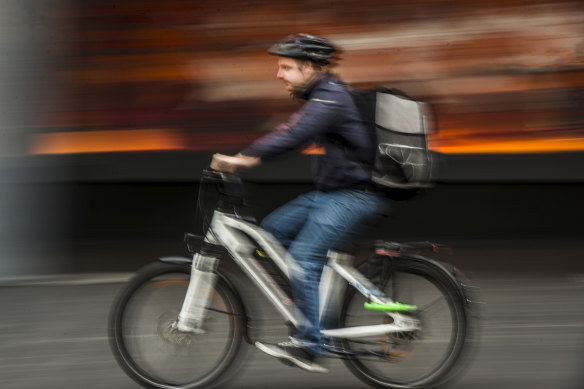When I first saw a Milkrun poster advertising grocery deliveries in just 10 minutes, it sounded as impossible as perpetual motion, or a constructive debate about the Voice. I couldn’t see how they could do it, unless Milkrun had built a teleporter, or tapped the energy of pre-schoolers high on Easter Show chocolate.
It was impossible, which is why Milkrun runs no more. But for a while, they managed through dozens of private inner-city convenience stores, and a flotilla of hipsters aboard electric bikes. I loved Milkrun and its competitors Voly and Send for sourcing RATs during lockdown, and urgent nappy deliveries for our newborn – that is, whenever I was happy paying extra not to leave the house. They were perfect for price-insensitive hermits.

Milkrun riders received holiday pay and super. Perhaps if the company had been stingier, it might have survived.Credit: Steven Siewert
The deliveries often ran late, but they compensated with generous discount codes. I felt good about ordering from the little guy, too, even though Milkrun was partially funded by the decidedly non-little Mike Cannon-Brookes and Scott Farquhar from Atlassian.
There were just a few other tiny problems – well, fatal problems. Milkrun was chronically understocked, and the more common an item was – like, erm, milk – the more likely it was to be “back soon”. Then there was competition like Woolies’ Metro60, offering deliveries within an hour from a much wider range.
Oh, and Milkrun lost money, a reported $10 an order on average as of June, and while CEO Dany Milham claimed an improvement since the early days (when it was $40 per order) it wasn’t exactly viable. It sounds like their most efficient deliveries were of investor cash – they burnt $86 million of it.
Loading
As sad as I am that the founders of Atlassian no longer subsidise our nappies, the main reason to mourn Milkrun is that unlike other app-based delivery services, they paid their staff properly.
Also, they hired them as staff, rather than independent contractors who didn’t have to be paid if there was a lull. Too often, the convenience of delivery services is built on massive job insecurity for the deliverers. That’s why apps nag us to tip them, and why precariously-employed riders so often swerve through equally precarious gaps in the traffic, increasing their chances of making a decent living, if not remaining alive. And there are a lot of them – a recent UWA study found UberEats had more employees (59,000) than WA’s Education Department.
In 2017, most of Australia’s workforce (56 per cent) were in insecure work – that is, jobs that weren’t full-time, and without basic entitlements like sick and holiday pay. So those Milkrun riders, getting full-time employment, holiday pay and super, were exceptions to the rule. Perhaps if the company had been stingier, it might have survived? The TWU reckons so.
Stay connected with us on social media platform for instant update click here to join our Twitter, & Facebook
We are now on Telegram. Click here to join our channel (@TechiUpdate) and stay updated with the latest Technology headlines.
For all the latest Business News Click Here
For the latest news and updates, follow us on Google News.
